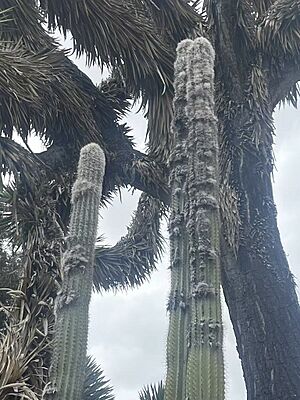Sonoran old man cactus facts for kids
Quick facts for kids Sonoran old man cactus |
|
|---|---|
 |
|
| Scientific classification | |
| Synonyms | |
|
Pilosocereus alensis, also known as the Sonoran old man cactus, is a type of cactus found in Western Mexico. It grows in areas from Sonora in the north down to Jalisco in the south. This cactus gets its "old man" name from the long, white hairs that cover its stems. These hairs are not just for show; they help protect the plant, especially its delicate flower buds.
Contents
What is the Sonoran Old Man Cactus?
The Sonoran old man cactus is a tall, column-shaped plant. It can grow quite large, reaching several meters in height. Its stems are usually blue-green and have ribs, which are common features of many cacti. The most noticeable thing about this cactus is its dense covering of white, woolly hairs. These hairs make it look like an old man's beard, giving it its common name.
Where Does it Grow?
This cactus is native to a region in Western Mexico. It thrives in the warm, dry climates found in states like Sonora, Sinaloa, Nayarit, and Jalisco. These areas are known for their unique desert and dry forest ecosystems. The cactus is well-adapted to these conditions, able to store water and survive long periods without rain.
What Does it Look Like?
The Sonoran old man cactus has a distinctive appearance. Its main stems are upright and can branch out. The white hairs are especially thick near the top of the stems, where the flowers grow. These hairs act like a natural sunscreen, protecting the cactus from the intense sun. They also help to reduce water loss by trapping a layer of cooler, moist air close to the plant's surface.
How Does it Reproduce?
Like many plants, the Sonoran old man cactus reproduces by making flowers and then fruits with seeds. This process involves special visitors that help the cactus spread its seeds.
Flowers and Pollination
The flowers of the Sonoran old man cactus are quite interesting. They typically open at night, usually in June. When they open, they release a strong smell, often described as smelling like ammonia. This unique scent is not for humans! It's a signal to attract specific animals that help with pollination. Bats are the main pollinators for this cactus. They are drawn to the strong smell and the nectar inside the flowers. As the bats feed, they carry pollen from one flower to another, helping the cactus reproduce.
Fruits and Seeds
After the flowers are pollinated, they develop into juicy fruits. These fruits are often tasty and are eaten by various animals. When animals eat the fruit, they help spread the seeds of the cactus to new locations. This allows new cactus plants to grow and helps the species continue to thrive in its natural habitat.
See also
 In Spanish: Pilosocereus alensis para niños
In Spanish: Pilosocereus alensis para niños

